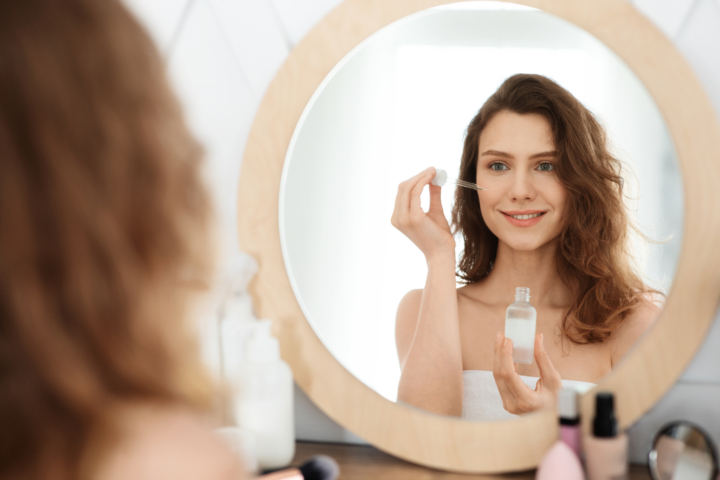
Sooner or later the moment comes when we notice the first wrinkles when we look in the mirror every morning. Whether on the forehead, on the eyes or around the mouth: Wrinkles are part of the normal aging process and arise from environmental influences and our lively facial expressions, which become more and more noticeable on our skin as elasticity decreases.
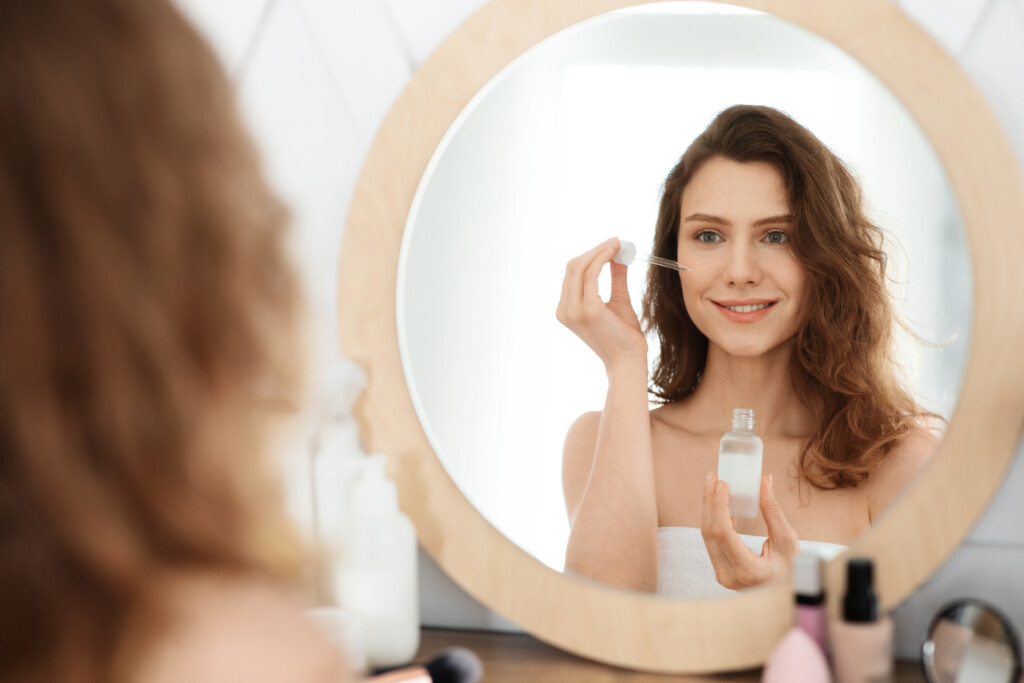
Even though smile lines only make a face more appealing, we still want to preserve the youthfulness of our skin for as long as possible. Two active ingredients are particularly popular for this: retinol or hyaluronic acid. Both substances have a positive effect on your skin and make your complexion shine. But how exactly do hyaluronic acid and retinol work? How are the active ingredients applied? And can there be side effects? In this article we will tell you whether retinol or hyaluronic acid really helps against wrinkles and what you should consider when using it.
Retinol or hyaluronic acid: This is what distinguishes the active ingredients
Hyaluronic acid and retinol are two completely different substances and therefore have different effects on your skin.
Retinol as a beauty miracle weapon
Retinol, also called Vitamin A is a fat-soluble, essential vitamin that plays an important role in building skin structure. If retinol or one of the milder precursors is applied to the skin, it is converted into the active retinoic acid. As an antioxidant, retinol serves as a free radical scavenger for the organism, protecting against impairment of cell function and premature skin aging. Therefore, the active ingredient should not only be applied in cosmetic products, but also absorbed in natural form in foods such as butter, fish, dairy products or egg yolk. Because no matter how good your cosmetic products are, your diet has an influence beautiful skin from the inside essential.
Cell regeneration and collagen production thanks to retinol
Since the skin loses its elasticity with age, retinol with its rejuvenating and smoothing effect is considered a true beauty miracle weapon: On the one hand, it stimulates cell renewal, but on the other hand it also stimulates cell growth. In addition, the skin's own collagen production is brought into high gear, which automatically makes the skin appear plumper and wrinkles are reduced. Thanks to its cell-regenerating effect, retinol also ensures an even, uniform complexion as it can reduce pigmentation disorders, discoloration and acne scars. Here you can also Acne treatment Berlin support.
Hyaluronic acid: The body's own substance for more moisture
Hyaluronic acid is a sugar-like substance ('polysaccharide', multiple sugar) that can not only be produced chemically, but is also produced in the human body itself. The body's own hyaluronic acid is, among other things, an essential component of connective tissue and promotes physical movement processes in the synovial fluid. However, the cosmetics industry takes advantage of a completely different property of the active ingredient: hyaluronic binds water. One gram of the substance can bind up to six liters of water and thus store a lot of moisture in the body - and the skin.
Hyaluronic acid plumps up and provides an instant glow effect
Due to its binding properties, hyaluronic acid is a popular ingredient in serums and creams - and delivers convincing results: Hyaluronic acid makes the skin look fresher immediately after use and plumps the skin from the inside, so that it immediately appears firmer. This makes the skin appear smoother. Thanks to the water molecules attracted by the hyaluronic acid, the moisture and elasticity of the skin are increased and dryness wrinkles are reduced.
The intensive hydration makes the complexion shine, provides new vitality and ensures an instant glow effect. Depending on which chain is used in serums, creams or masks, hyaluronic acid can be more or less effective. In a direct comparison, low-molecular-weight hyaluronic acid is significantly more effective, effective and longer-lasting than high-molecular-weight hyaluronic acid.
Particularly practical: Hyaluronic acid is also suitable for sensitive skin because it is a particularly mild active ingredient.
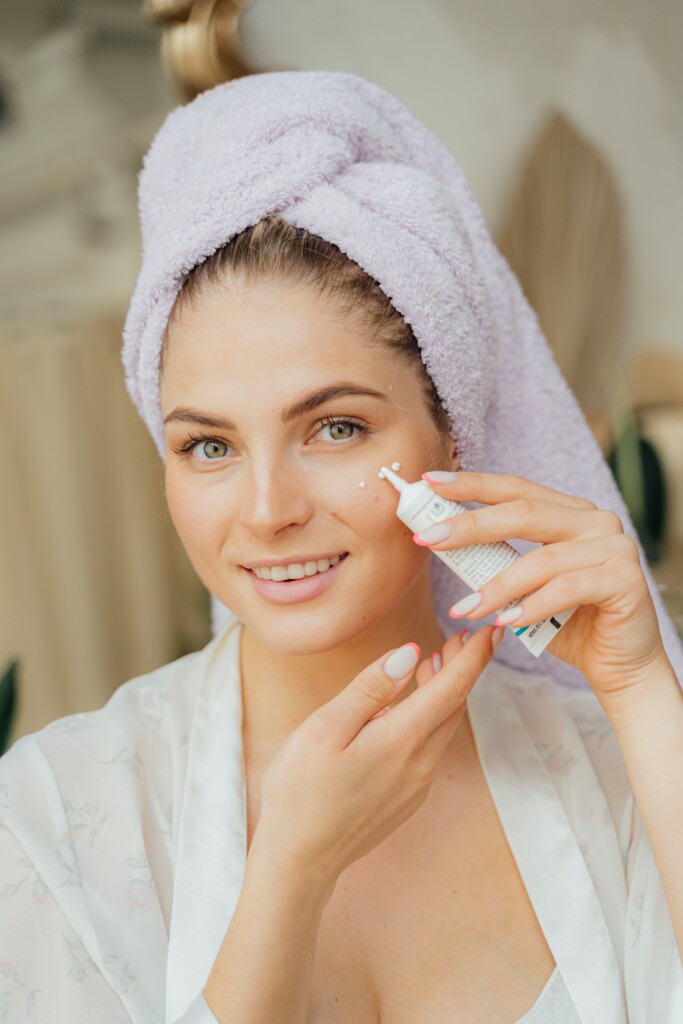
Correct use of retinol or hyaluronic acid: This is how they work best
In order for the anti-aging product of your choice to have its optimal effect, you should definitely ensure that it is used correctly and that meets your skin needs.
Retinol: Regular use for visible results
It is best to apply a retinol serum in the evening after cleansing your face. The effectiveness of your serum depends on the concentration: the further away the active ingredient is in the conversion chain from active retinoic acid, the less effect you will see on your skin. We therefore recommend that you use retinol or retinal (dehyde). At the beginning of your new skincare routine, start with a low concentration, such as 0.1 percent retinol. Use it twice a week until your skin gets used to it. Then you can increase the active ingredient concentration to 0.3 percent retinol or 0.05 percent retinal and use your serum daily.
Sanft & Schöntip: Store your retinol serum in the fridge! Thanks to the stable temperature, the effect of the active ingredients is retained for longer.
Although retinol is an absolute miracle weapon in the anti-aging sector, it requires a little patience until you can actually see visible results. The creation of new, additional collagen fibers takes not just weeks, but sometimes months and requires regular and long-term use of the cosmetic product. However, studies have shown that 'regularly' doesn't necessarily have to mean daily: if you use the serum one to three times a week, you will get effective results. You will notice the first changes in the superficial effects after about a month.
Important: Retinol stimulates cell renewal, which greatly reduces your skin's own protection against UV radiation. Therefore, use a cream with SPF 30 or more every day to protect your fresh skin cells.
Mild but effective: hyaluronic acid
A hyaluronic serum is applied to slightly damp skin immediately after cleansing your face, gently patted in and incorporated into the skin with a moisturizer. You can easily use hyaluronic acid daily up to a concentration of two percent. This means that the active ingredients develop optimally on your skin and you can see the first differences after about a week.
For a special glow effect, you should use hyaluronic acid twice a day: in the morning the serum soothes your skin, in the evening it protects against moisture loss and promotes skin regeneration. Your skincare routine with hyaluronic acid is ideally complemented by a regular one Aquafacial Berlin Mitte – this provides your skin with an extra portion of moisture.
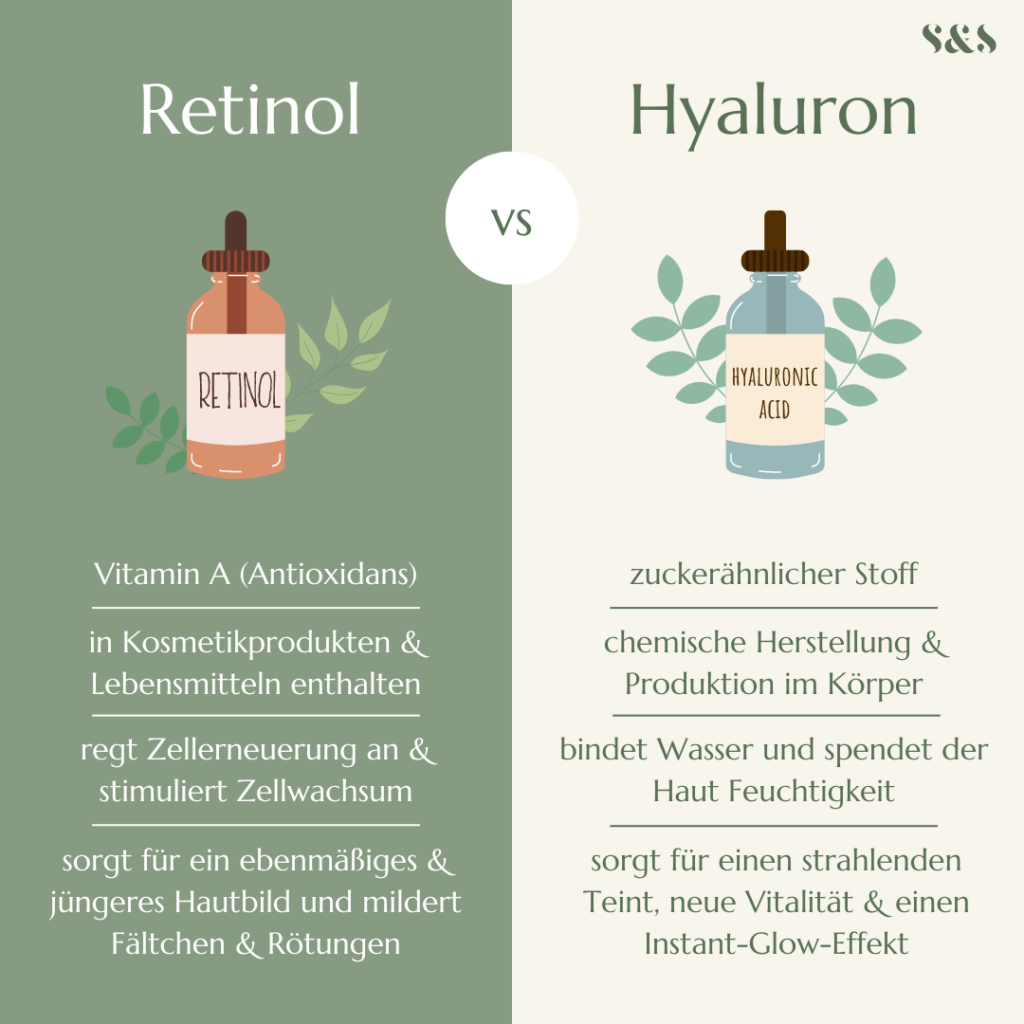
Retinol or hyaluronic acid? Layering as an ideal solution for all skin needs
Why choose one active ingredient when you can have both? You don't have to choose retinol or hyaluronic acid, but you can combine the benefits of both substances using effective layering.
The so-called 'layering' describes the successive application of different skin care active ingredients and follows strict rules because: Not all active ingredients can be easily combined. With hyaluronic acid and retinol, however, you don't have to worry about side effects from the wrong combination. However, high-dose prescription retinoids are an exception.
Layering not only combines the advantages of both substances, but can also compensate for side effects. For example, hyaluronic acid prevents dry, itchy skin that can occur when using retinol.
For correct layering, use the sandwich technique: Apply hyaluronic acid to your slightly damp skin in the morning and evening after cleansing your face and gently pat in the serum. Once the serum has been absorbed, the retinol can be incorporated. Finally, you should apply a moisturizer that locks the active ingredients into the skin. The combination of retinol and hyaluronic acid is ideal if you Care for combination skin want or suffer from dry, sensitive or dehydrated and impure skin.
What side effects can occur with retinol or hyaluronic acid?
Active ingredients not only have positive effects on your skin, but can also cause side effects - depending on your skin type. This can occur both immediately after the first application and after using the product for a long time. The same goes for retinol or hyaluronic acid.
Retinol: Watch out for these side effects
You are wondering whether retinol or hyaluronic acid is the right active ingredient for you Skin care routine is? Depending on how sensitive your skin is, only one of the two active ingredients may be suitable for you. Since retinol has a particularly intensive effect on the skin, its use can cause redness, burning or severe itching. These are signs of the so-called 'rentinol burn' or classic allergies.
This is why retinol burn occurs
Why does retinol burn happen? The cause actually lies in the effect of the substance on the skin. If retinol is applied, cell turnover increases: On the one hand, cells can regenerate more quickly, and on the other hand, dead skin cells are used more quickly so that new ones can form. If retinol is used too often, the high cell turnover can cause retinol burn. The fresh cells on the skin surface are very sensitive and react intensively to environmental influences.
These are signs of a retinol burn:
- Flaking skin
- irritated skin, also painful
- Skin dryness
- Redness or other color changes
Typically, these signs appear within 24 hours of first use or with excessive use and can last up to a week. If you have retinol burn, you should reduce the frequency of use of your cosmetic product until your skin has regenerated again.
Sanft & Schöntip: Give your skin time and slowly get used to using retinol. Therefore, initially do not use your serum as a daily care product, but rather twice a week. After a few weeks you can increase the frequency.
Retinol or hyaluronic acid: This is how a retinol allergy manifests itself
Allergies are triggered by an overreaction of the immune system to stimuli that are actually harmless - this can also include the use of retinol if the skin is sensitive. Your skin will either react to the retinol within a few minutes or develop an allergy over the course of weeks. Therefore, after application, pay attention to any skin changes that may indicate intolerance:
- painful skin changes
- itching
- swelling
- Redness
Do you notice one or more of these signs after using retinol or hyaluronic acid? Then you should stop using the cosmetic product and consult a dermatologist.
Using hyaluronic acid: Can there be side effects?
The good news for all hyaluronic acid lovers: Hyaluronic acid is particularly well tolerated because it is a substance produced naturally in the body. Although allergic reactions can occur, these are extremely rare and are usually caused by an allergy to other ingredients in your cosmetic product. If skin irritation occurs after using hyaluronic acid, take a look at the small print. Substances such as parabens, silicone compounds or essential oils in particular can cause severe reactions on sensitive skin.
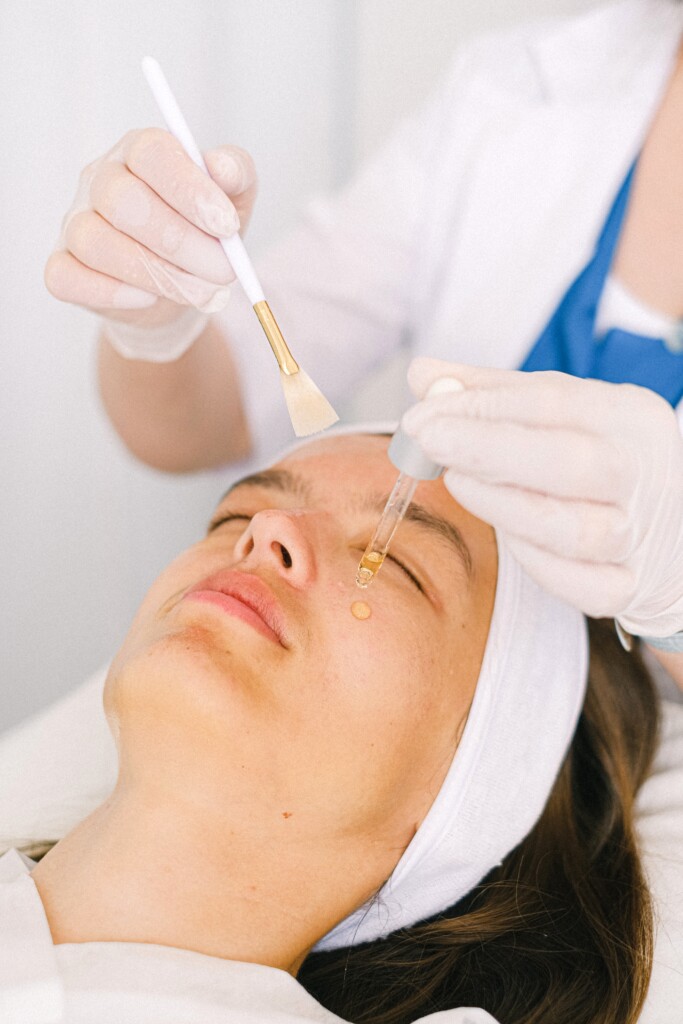
Retinol or hyaluronic acid during pregnancy and breastfeeding
If you are considering whether retinol or hyaluronic acid are allowed during pregnancy and breastfeeding, you should be well informed and err on the side of caution.
Especially vitamin A in tablet form as a cure for acne or psoriasis, but also prescription retinoid creams must under no circumstances be used if you are pregnant or planning to become pregnant. Severe malformations and developmental problems in the baby can be one of many consequences.
According to studies, over-the-counter retinol products are only marginally absorbed through the skin and have a very low chance of affecting the baby's development. Nevertheless, doctors recommend that you stop using cosmetics containing retinol during pregnancy and breastfeeding so as not to take any risks.
Instead, you can switch to harmless anti-aging ingredients, such as hyaluronic acid. This is safe for mother and unborn child both during pregnancy and breastfeeding and can be used without hesitation.
Conclusion: Retinol or hyaluronic acid – which actually works?
Do you want to integrate retinol or hyaluronic acid into your skincare routine and are you wondering which active ingredient actually helps against wrinkles?
Retinol is our favorite as a beauty miracle weapon: your skin benefits from it in several ways! Retinol is an antioxidant, has a cell-protecting effect, stimulates skin regeneration and accelerates collagen production. You have impure skin or do you suffer from pigmentation disorders? The active ingredient ensures a clear, even complexion, as the sebaceous glands and melanin formation are also regulated by retinol. However, approach the use of retinol products slowly and let your skin get used to the active ingredient over a longer period of time. If you have very sensitive skin or are pregnant or breastfeeding, you should use other effective substances.
Hyaluronic acid, on the other hand, is a very compatible active ingredient because it also occurs naturally in the human body. Compared to retinol, hyaluronic acid shines with other strengths: thanks to its water-binding properties, it supplies your skin with lots of moisture, fills in the first wrinkles and makes your skin appear noticeably plumper.
Regular professional facials such as Microneedling Berlin Mitte or Microdermabrasion Berlin Mitte help maintain youthful, radiant skin and ideally complement your skincare routine.
Sanft & Schöntip: Combine both ingredients in your skincare routine using layering! They complement each other perfectly and you benefit from the advantages of both substances.